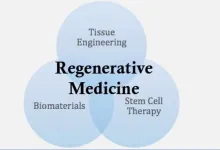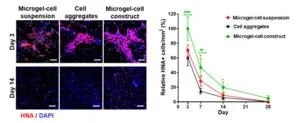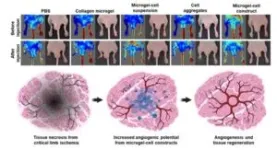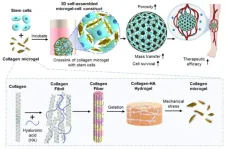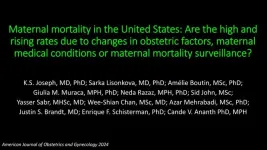(Press-News.org)
One of the primary goals in the field of tissue engineering and regenerative medicine is the development of artificial scaffolds that can serve as substitutes for damaged tissue. These materials must ideally resemble natural tissue and must have the ability to support cell adhesion, proliferation, and differentiation. When considering scaffold materials, researchers account for the scaffold’s properties, such as its surface roughness, its water content (hydration state), and its flexibility or stiffness (elastic modulus), since these properties are known to affect cell growth.
Hydrogels are biocompatible cross-linked polymers with high water content and are a promising scaffolding material for soft tissue. They can be designed with different elasticities, which can match the mechanical properties of various natural tissues. However, their elastic modulus is linked to their composition, resulting in a difference in the characteristics between softer and harder hydrogels.
To study the specific effect of the hydrogel’s elasticity on cell growth, a research team led by Assistant Professor Shin-nosuke Nishimura and Professor Tomoyuki Koga from Doshisha University, Japan, has developed a hydrogel with tunable elastic moduli using the same polymers. The findings of their study were published in the journal Advanced Material Technologies on February 9, 2024.
"The elastic modulus of hydrogels is one of the most crucial factors in controlling the fate of cells," explains Dr. Nishimura. However, hydrogels with different elasticities are usually prepared by changing the base monomer and the crosslinking agent. This affects not only the elasticity but also various characteristics, such as hydrophilicity and hydrophobicity.
To avoid this problem, the researchers designed the hydrogel without any crosslinks. They used poly(N-acryloylglycinamide) (PNAGAm) as the base polymer, a vinyl polymer with side chains that form strong hydrogen bonds. These bonds break at high temperatures and reattach at lower temperatures, giving these polymers the unique capability to remember and recover their shape in response to temperature changes.
To improve cell adhesion properties of the hydrogel, the researchers combined the PNAGAm polymer with arginine (R)–glycine (G)–aspartic acid (D)–serine (S) peptide through radical copolymerization. These peptides represent the cell-binding sites found in the body and make the hydrogel suitable for cell growth.
Unlike conventional hydrogels, the elastic modulus of the proposed hydrogel can be adjusted by compressing it into different thicknesses at high temperatures. When exposed to high temperatures, the hydrogen bonds within the polymer break and compressing the hydrogel under such conditions brings the polymer network and hydrogen-based crosslinks closer together. This change in the molecular structure leads to a modification of the hydrogel's elastic modulus. Upon cooling, due to the reattachment of the hydrogen bonds, the hydrogel maintains both its shape and elastic modulus.
By using this method, the researchers successfully changed the elastic modulus of a rectangular hydrogel bar. They compressed different sections of the hydrogel to thicknesses of 1 mm, 0.64 mm, and 0.50 mm at 65 °C for an hour. On cooling it to a cell-culturing temperature of 37 °C, the non-pressed, moderately pressed, and firmly pressed regions had elastic moduli of 9460 Pa, 5940 Pa, and 3460 Pa, respectively.
On seeding the hydrogel with mouse embryo fibroblast (NIH/3T3) cells, the researchers observed a direct correlation between the elastic modulus of the hydrogel and the number of adhered cells. In the unpressed region, the number of adhered cells was 1.3 × 104 cells cm−2, whereas in the firmly pressed region, it increased to 1.9 × 104 cells cm−2.
“In this study, we have succeeded in controlling cell adhesion behavior for the first time in the world by utilizing the shape memory properties of hydrogels,” says Prof. Koga.
In conclusion, by altering the elastic modulus while keeping other properties consistent, the researchers created a platform which can be used to investigate the influence of elastic modulus on cell growth. This can lead to improved scaffolding materials for tissue regeneration!
About Assistant Professor Shin-nosuke Nishimura from Doshisha University, Japan
Shin-nosuke Nishimura is an Assistant Professor at the Faculty of Science and Engineering, Department of Molecular Chemistry and Biochemistry at Doshisha University. His research interests lie in the fields of nanotechnology/materials, organic functional materials, polymer chemistry, green/sustainable/environmental chemistry, and bioorganic chemistry. He has published numerous papers and written several books, covering the areas of organic chemistry, biomaterials, hybrid materials, peptide chemistry, and polymer chemistry. Dr. Nishimura is also a member of several scientific societies, such as The Chemical Society of Japan, MRS Japan, The Society of Biomaterials Science, Japan, and The Society of Polymer Science, Japan.
Funding information
This work was supported by a Grant-in-Aid for Scientific Research (KAKENHI) (JP22K05232 to T.K.) from the Japan Society for the Promotion of Science (JSPS). This research was also supported by Grant-in-Aid for the Japan Prize Foundation (to S.N.), Lotte Research Promotion Grant (to S.N.), and All Doshisha Research Model “SDGs Research Project” (to T.K. and S.N.).
Media contact:
Organization for Research Initiatives & Development
Doshisha University
Kyotanabe, Kyoto 610-0394, JAPAN
E-mail:jt-ura@mail.doshisha.ac.jp
END
Critical limb ischemia is a condition in which the main blood vessels supplying blood to the legs are blocked, causing blood flow to gradually decrease as atherosclerosis progresses in the peripheral arteries. It is a severe form of peripheral artery disease that causes progressive closure of arteries in the lower extremity, leading to the necrosis of the leg tissue and eventual amputation. Current treatments include angioplasty procedures such as stent implantation and anti-thrombotic drugs, but there is a risk of blood vessel damage and recurrence of blood clots, which is why there is a strong interest ...
Philadelphia, March 13, 2024 – A new study published in the American Journal of Obstetrics & Gynecology, published by Elsevier, challenges the prevailing view on the maternal death rate in the United States. The findings show that the rates of maternal death were stable between 1999-2002 and 2018-2021, instead of the dramatic upward trends previously reported by the National Vital Statistics System (NVSS), Centers for Disease Control and Prevention (CDC). Additionally, the study indicates that direct obstetric causes of death declined over the last 20 years.
To determine whether the reported maternal death rates are accurate, a team of researchers took a deep dive into ...
Maternal death rates in the United States may be sharply overstated as a result of faulty surveillance techniques, according to an analysis by researchers at Rutgers Health and other universities.
The National Vital Statistics System (NVSS) of the Centers for Disease Control and Prevention (CDC) estimates that maternal death rates have more than tripled over the last two decades to 32.9 deaths per 100,000 live births in 2021 – substantially more than in any other wealthy nation.
The new study that looked at all deaths in the United States from 1999 to 2021 published in The American Journal of Obstetrics and Gynecology reports consistent death rates of slightly ...
What: Researchers at the National Institutes of Health (NIH) have discovered that symptoms of attention-deficit/hyperactivity disorder (ADHD) are tied to atypical interactions between the brain’s frontal cortex and information processing centers deep in the brain. The researchers examined more than 10,000 functional brain images of youth with ADHD and published their results in the American Journal of Psychiatry. The study was led by researchers at NIH’s National Institute of Mental Health (NIMH) and National Human Genome Research Institute.
Luke Norman, Ph.D., a staff scientist in the NIMH Office of the Clinical Director, and colleagues ...
Laser direct writing (LDW) current researches mostly generate single type of materials for sensing layers or electrodes, while the sensor with different types of materials by LDW method is lacked. Researchers led by Prof. Gao Yang from East China University of Science and Technology (ECUST), China, are interested in expanded the application of LDW method, where can utilize the photo-thermal conversion, to synthesize materials and then engrave them with the desired morphologies and structures.
Focusing on the functionality of materials, the researchers use all-LDW method to generate laser induced silver (LIS) as electrodes and laser induced graphene ...
More than 80% of patients with tuberculosis, the world’s most deadly infection, do not have a persistent cough, despite this being seen as a key symptom of the disease. The infection is predominantly transmitted by coughing, but probably also through simply breathing. Research, led by Amsterdam UMC and the Amsterdam Institute for Global Heath and Development, analysed data on more than 600,000 individuals in Africa and Asia and found that 82.8% of those with tuberculosis had no persistent cough and 62.5% had no cough at all. These results ...
Women with a short cervix around 20 weeks of pregnancy have an increased risk of preterm birth. Preventing preterm birth in pregnant women with a short cervix is a crucial step in protecting the health of the child. Research from Amsterdam UMC now shows that, in pregnant women with a short cervix around 20 weeks, Progesterone (a hormone) is better than a cervical pessary at reducing the risk of severe preterm birth. This study was published today in the BMJ.
"This is an important improvement that can contribute to the reduction of preterm births and the associated complications, such as an increased risk of infant mortality and long-term health problems for the child," says ...
Girls with obesity are more likely to experience pain in their bones, joints, muscles, ligaments or tendons compared with children with a healthy weight, according to research by Queen Mary University of London. The same did not apply to boys.
Queen Mary researchers hope their findings will raise awareness that obesity may contribute to musculoskeletal problems in children.
In the study, published today in Archives of Disease in Childhood, researchers analysed anonymised information on 120,000 children, linking data from the National Child Measurement Programme with GP records. They found that girls with obesity were 1.7 times more likely than those ...
A new analysis led by researchers at the University of Oxford and funded by the Nuffield Foundation has found that virtually all care homes forced to close in England by the Care Quality Commission are run on a for-profit basis. The results, published today in The Lancet Healthy Longevity, raise questions about the role of the private sector in exacerbating the care sector’s ongoing crisis.
The study assessed the number of care homes which had been forced to close by the independent regulator of health and social care in England, the Care Quality Commission ...
Cancer patients who received specialized mental health support as part of their treatment plan are more likely to see improvements in their quality of life and reductions in pain, depression and fatigue, according to a study led by researchers at the University of Pittsburgh School of Medicine.
In addition to lasting improvements in patients’ quality of life, researchers observed lower risk of cardiovascular disease in family caregivers, as well as substantial cost savings to the healthcare system. The findings from a Phase III clinical trial were published today in The Lancet.
“The ...
